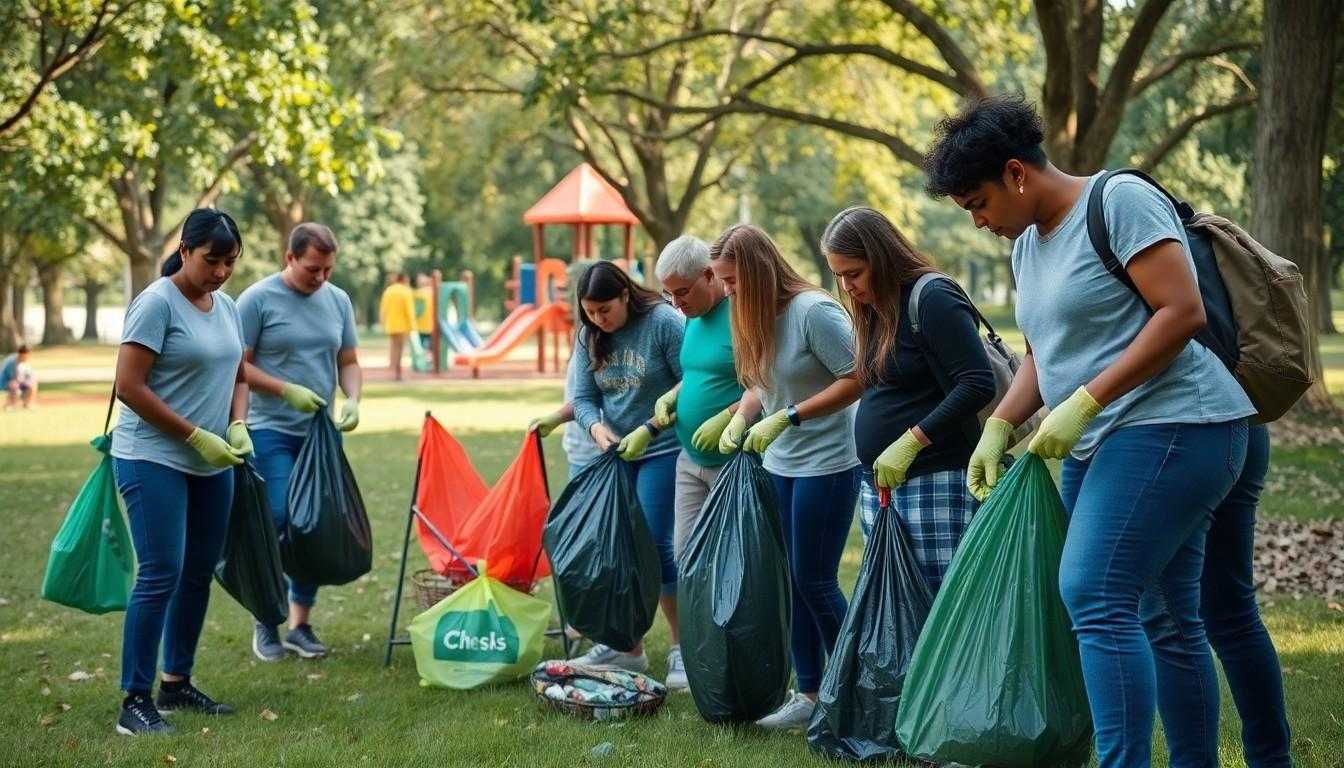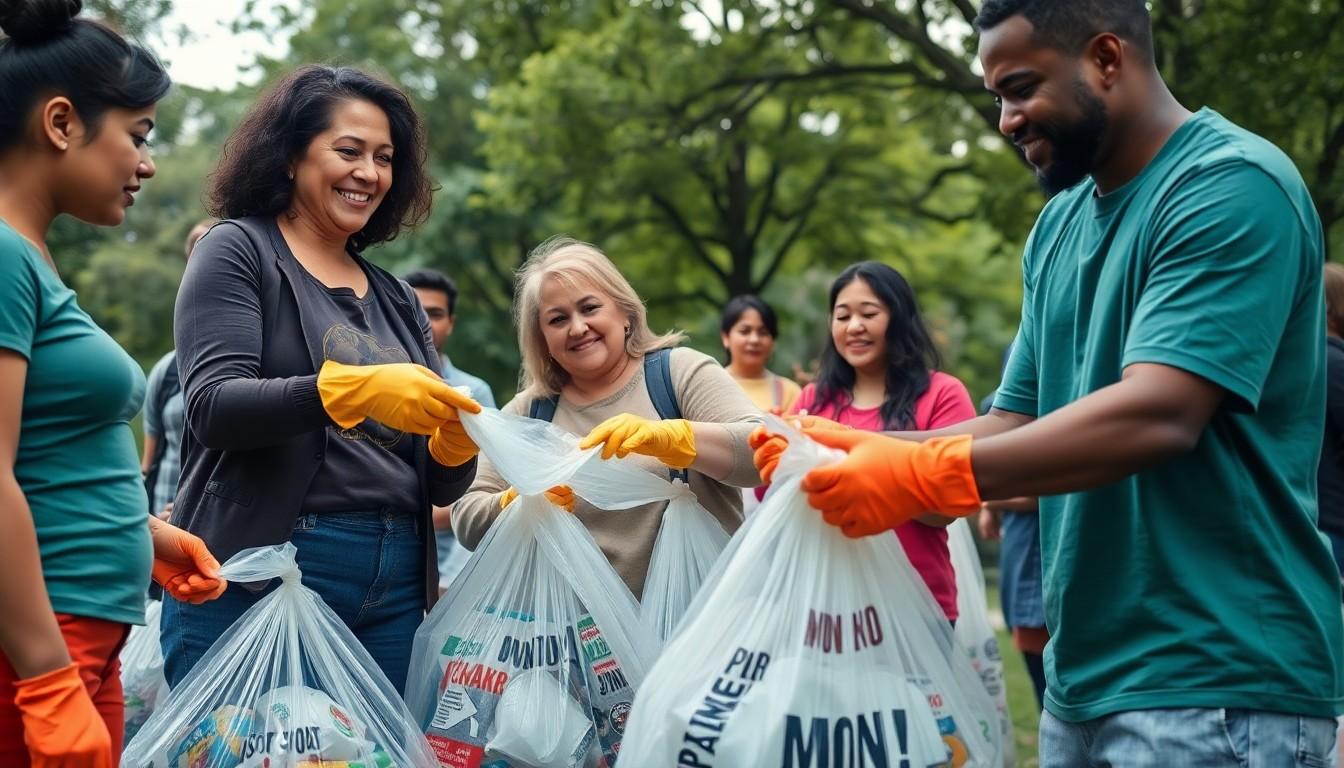Local environmental issues might not sound as thrilling as the latest blockbuster, but they’re the real-life drama unfolding right in your backyard. From plastic pollution to dwindling green spaces, these challenges affect everyone, whether they’re sipping coffee at a local café or jogging through the neighborhood park. Ignoring them is like skipping leg day—eventually, it catches up with you.
Local Environmental Issues
Local environmental issues encompass various challenges that directly impact communities. Plastic pollution remains a top concern, with millions of tons entering ecosystems each year. This pollution harms wildlife and disrupts natural habitats. Loss of green spaces significantly affects urban areas, limiting biodiversity and increasing the urban heat island effect. Communities that lack access to parks face health issues, including respiratory problems.
Air quality poses another serious concern. Increased vehicle emissions lead to health problems for residents, particularly children and the elderly. Water pollution is equally critical, with contaminants entering local waterways from industrial runoff and improper waste disposal. This pollution threatens drinking water sources and aquatic life.
Community engagement plays a vital role in addressing these problems. Local organizations often spearhead initiatives to raise awareness and promote sustainable practices. Education about recycling and responsible consumption fosters a more environmentally conscious community. Involving residents in clean-up events can instill a sense of responsibility toward local ecosystems.
Climate change exacerbates these issues, driving shifts in weather patterns. Increased flooding, droughts, and heatwaves affect agriculture and water supply. Communities that adapt to these changes face economic challenges, particularly in agriculture-dependent regions. Addressing local environmental issues requires collaboration between residents, businesses, and government agencies.
Mitigating these impacts involves implementing sustainable practices. Encouraging public transportation use reduces emissions significantly. Supporting local initiatives focused on sustainability creates a positive effect on the environment. Investing in renewable energy sources enhances community resilience against climate change.
Common Local Environmental Issues

Local communities face various environmental challenges that affect health and quality of life. Addressing these issues is essential for sustainable living.
Air Pollution
Air pollution impacts many urban areas due to vehicle emissions and industrial activities. Within cities, particulate matter and nitrogen dioxide levels frequently exceed safety limits, compromising residents’ health. Vulnerable populations—children, the elderly, and people with preexisting conditions—experience increased respiratory issues, contributing to higher healthcare costs. Programs promoting public transportation reduce traffic congestion and emissions. Community awareness campaigns about air quality encourage individuals to use carpooling or biking instead of driving.
Water Quality
Water quality remains a pressing concern for many towns and cities. Contamination often stems from industrial runoff, agricultural practices, and sewage leaks, compromising drinking water safety. Contaminants like nitrates and heavy metals can disrupt ecosystems and affect human health. Regular monitoring of local water sources establishes baseline data for addressing pollution. Community clean-up initiatives and education about proper chemical disposal can improve overall water safety.
Waste Management
Waste management challenges arise from increasing populations and consumer habits. Landfills overflow as single-use plastics and organic waste accumulate, leading to soil and water contamination. Efficient recycling programs reduce the volume of waste sent to landfills and promote resource conservation. Communities can implement composting systems to handle organic waste, diverting it from landfills and enriching soil. Residents trained in waste sorting ensure recycling efforts are effective, fostering a culture of sustainability within the community.
Impact of Local Environmental Issues
Local environmental issues directly affect communities. Understanding their impact is crucial for everyone.
Effects on Public Health
Public health suffers due to local environmental challenges. Air pollution leads to respiratory diseases, particularly affecting children and the elderly. Poor air quality increases hospital visits for asthma and other illnesses. Contaminated water sources pose significant health risks, causing gastrointestinal issues and long-term conditions. Regular exposure to polluted environments correlates with decreased life expectancy. Community members face increased healthcare costs, straining local resources.
Effective solutions involve promoting clean air initiatives and ensuring safe water supplies. Educational programs raise awareness about health risks and encourage protective measures.
Effects on Local Wildlife
Local wildlife faces threats from environmental issues. Plastic pollution disrupts aquatic habitats and endangers marine life. Species ingest or become entangled in debris, leading to injury or death. Loss of green spaces reduces biodiversity in urban ecosystems, resulting in diminished populations of native species. Air and water pollution contribute to habitat degradation, making survival more challenging for wildlife.
Conservation efforts require community engagement to restore habitats and prioritize protection. Implementing wildlife-friendly practices supports a healthier ecosystem.
Solutions to Local Environmental Issues
Addressing local environmental challenges requires concerted efforts from various stakeholders. Implementing effective solutions fosters a healthier community and ecosystem.
Community Involvement
Active participation from community members plays a crucial role in environmental protection. Residents can engage in local clean-up events to directly address pollution and habitat degradation. Community gardens promote green spaces, enhancing biodiversity and providing fresh produce. Workshops on recycling educate citizens about waste reduction, leading to responsible consumption behaviors. Collaboration with local organizations amplifies awareness of environmental issues, fostering a culture of sustainability. Moreover, schools can implement environmental curricula, instilling eco-friendly practices in future generations.
Policy Changes
Necessary policy changes ensure long-term resilience against environmental challenges. Local governments can enforce stricter regulations on waste disposal, curbing plastics’ harmful impact. Implementing incentives for public transportation encourages reduced vehicle emissions, benefiting air quality. Zoning laws that prioritize green spaces enhance urban landscapes and support biodiversity. Involving community input in policy-making processes strengthens trust and ensures alignment with residents’ needs. Funding for renewable energy projects propels local economies while addressing climate change, creating an advantageous environment for both citizens and wildlife.
Healthier Communities and Ecosystems
Addressing local environmental issues is essential for fostering healthier communities and ecosystems. By actively engaging in sustainable practices and supporting local initiatives, residents can make a significant impact on their surroundings.
Promoting awareness and education around topics like plastic pollution and air quality not only empowers individuals but also strengthens community bonds. As local organizations lead the charge in conservation efforts, it’s crucial for everyone to participate and advocate for meaningful policy changes.
Together, these collective actions can lead to a more sustainable future, ensuring that local environments thrive for generations to come.

